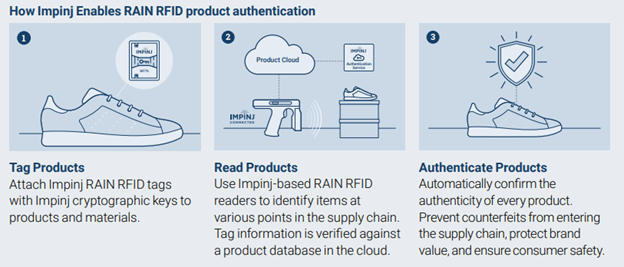The How and Why of RAIN RFID Cryptographic Authentication
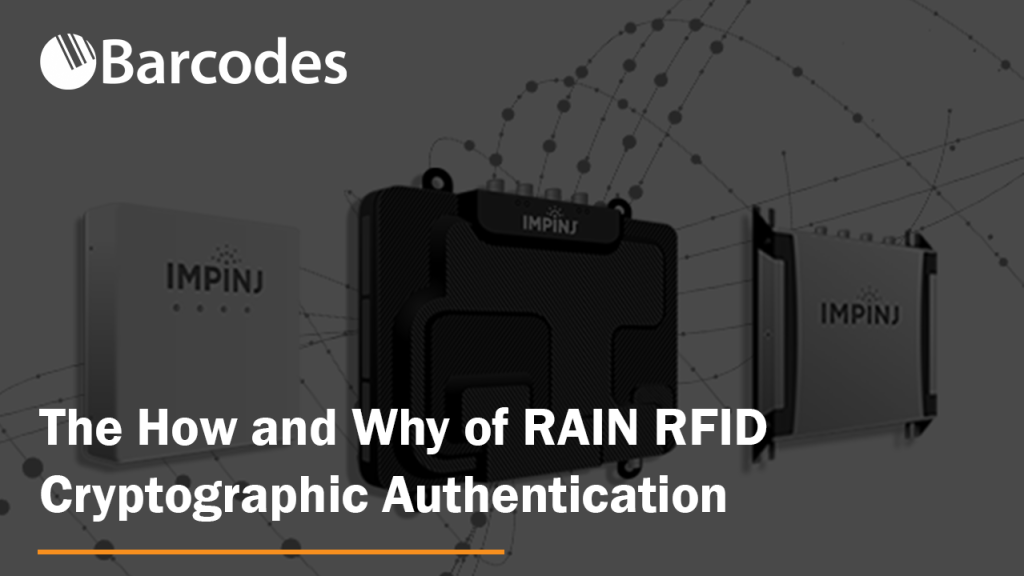
The problem of counterfeit products is global, and it’s growing. Knockoff handbags, athletic shoes, wristwatches, and pharmaceuticals cost businesses and consumers billions of dollars every year globally.
Now, there’s a new way brands can fight fakes: RAIN RFID cryptographic authentication.
The Impinj Authenticity™ solution engine brings enterprise-scale product authentication to new and existing RAIN RFID deployments.
What is Product Authentication?
At its heart, authenticating something is largely straightforward: You want to conclusively establish the item as genuine and determine its owner or origin. Doing that can get complex.
Product authentication solutions built on the Impinj platform employ secure cryptography, using a challenge-response protocol to determine with a high degree of certainty whether an item is genuine.
RAIN RFID from Impinj
An item tagged with RAIN RFID has certain information associated with it—data such as the manufacturer name, model number, serial number, date of manufacture, purchase date, customer name, and more. That item-specific data can be stored in a product cloud.
When that item is read at any point in the supply chain by a RAIN RFID reader, an Impinj-based authentication solution cross-checks and confirms the information stored in the product cloud and verifies the tag’s authenticity using the Impinj Authentication Service.
Impinj Authenticity uses cryptographic authentication, a feature of the new RFID tag chips, to swiftly and automatically verify tagged products as genuine.
Implement RAIN RFID with a Trusted Partner
For an in-depth explanation of how Impinj Authenticity works, contact Barcodes, Inc. to learn more about RAIN RFID.
RFID Webinar: Improve Returnable Container Tracking with RFID
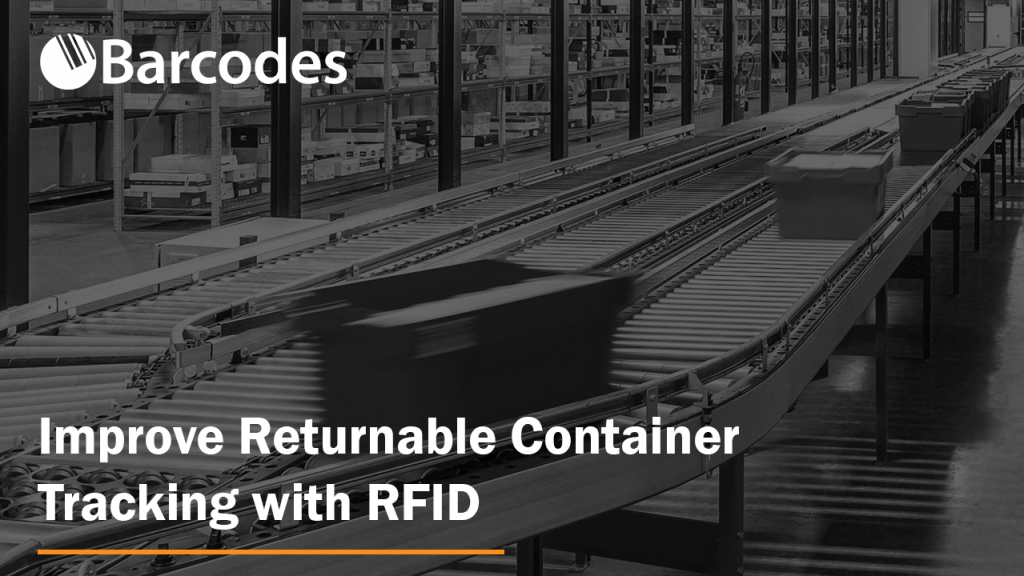
Webinar
Improve Returnable Container Tracking with RFID
Thursday April 20th 1:00-1:45pm Central
PRESENTED BY:
Christopher Vassilos – Senior Solutions Architect, Barcodes Group
Michael Daily – Senior Solutions Engineer, Impinj
RFID-Based Container Tracking
Upon delivery, it’s common for reusable containers to not be returned to the sender, with annual shrinkage rates often exceeding 10%. Keeping track of your Returnable Transport Items (RTIs) can be challenging, especially when logging their location depends on manual processes like scanning.
In this webinar, discover the benefits of RFID-based container tracking:
- Reduce the number of misplaced pallets, kegs, and boxes. Less new delivery assets need to be purchased, and shipments are not interrupted due to lack of totes.
- Track each asset as it leaves and returns to the warehouse, allowing you to determine its exact location immediately and whether they have yet to return.
- Calculate the flow of returnable assets to fully understand your shipping capacity for the present and future.
- Improve utilization of workers since it takes way less time to scan RFID tags than barcodes, due to its fully automatable reading without line-of-sight requirements.
Watch the Full RFID Webinar Recording
Improve Returnable Container Tracking with RFID

Returnable Transfer Items (RTIs), or returnable containers are critical assets for almost all manufacturing and logistics organizations. RTIs transport stock and commodities from one site to another. However, keeping track of your RTIs is a different story. Well-known manufacturers and logistics expert still often rely on manual methods, such as traditional scanning, spreadsheet, or pen and paper.
This leads to a major issue: inventory shrinkage.

Mismanagement of returnable containers owing to theft, unrecorded damage, or simply the inability of consumers to return empty pallets, kegs, and boxes costs a fortune.
How are Your Returnable Transfer Items Being Tracked Currently?
Barcode labels used to tag the cargo of a container during shipment are often non-permanent. Traditional barcode scanners and labels identify the contents of the container, but seldom provide reverse logistics tracking for the containers themselves.
Using permanent barcode labels as the foundation for a container monitoring system is not feasible. I know that might be strange to hear from a company called Barcodes, Inc. But scanning labels at various stages of the supply chain sometimes necessitates extra human effort, which is even more difficult when empty containers pile up.
One solution is to establish a tracking system utilizing modern asset tracking technology.
Reducing Yearly Inventory Shrinkage with RFID
“15% of all pallets in circulation vanish” or “20% of all packaging/equipment is lost owing to consumers retaining them for their own use or third parties removing them for their own use.”
SLS RFID 2016 Study
Inventory shrinkage is a major issue in the management of returnable transfer items (RTIs), which include all types of shipping containers, packaging, pallets, kegs, and boxes.
Shrinkage due to theft, unreported damage, or just consumers failing to return empty containers is a serious concern in this field.
Estimated annual shrinkage rates are anywhere from 3 to 9%. If you’re constantly replacing lost or stolen RTIs, the impact on profitability is a huge problem.
For organizations to decrease RTI shrinkage, RFID is appealing due to completely automated scanning without line-of-sight, as well as mass tag reading. The key advantage of RFID-based container monitoring systems is an improvement in container return rates. New containers are purchased in smaller batches and less frequently.
What Data Can Be Tracked with RFID Tags?
Integrating the RFiD Discovery system with your ERP system enables company-wide visibility of your RTIs, ensuring that essential assets are accessible at the relevant locations to fulfill any transportation request.
Exactly what the RFID ultimately tracks depends on your unique tracking requirements. Here are some examples of the depth of data you can store in a small RFID tag:
- Container Name
- Size
- Location
- Weight
- Item Quantity
- Container Properties
User memory on tags stores data. The serial number field can be pre-programmed or user-assigned.
The air-interface protocol standards for passive HF and UHF tags, such as UHF EPC Gen 2, define basic functions like read-write and which memory banks or blocks can be written to. Reader manufacturers include these low-level commands with higher-level subroutines in their software development kits for application developers.
How to Use RFID to Tag RTIs
RFID labels are long-lasting and more durable than traditional labels. RFID tags attach exceptionally well to returnable cargo and resist machine washing operations as well as harsh elements for much longer.
Any RTI equipped with an RFID tag can be detected by a small number of strategically located readers. The location data is delivered back to the central RFID Discovery database, where it may be evaluated.
This database allows you to discover how many RTIs have been sent to a specific supplier or customer, so you know which trade partner to approach when requesting a return.
When shipping containers are in range of an RFID reader, the information on the tags can be automatically acquired using a wide variety of methods:
- Fixed reader installed at a warehouse entrance or loading dock
- A mobile reader installed on a forklift
- Handheld reader brought inside a business partner’s facility for rapid inventory
What are the Main Advantages of Using RFID for Returnable Asset Tracking?
There are several advantages of using RFID to track returnable assets.
1. Recoup Billions of Dollars in RTI-Related Losses
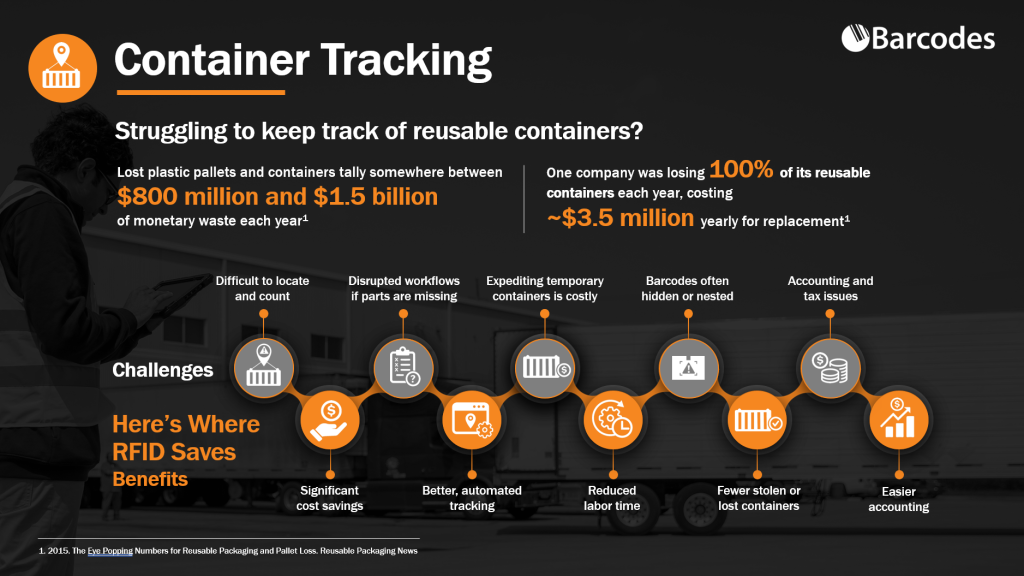
Reusable assets are returned to the sender after delivery, usually full of new goods and not empty. Entire industries are dedicated to capitalizing on reverse logistics and maximizing the value of containers.
So why do we pay far less attention to reusable assets compared to sold commodities and container space? In order to get a bird’s eye view of costly shrinkage areas, your immediate shipping capacity, and overall supply chain health, it’s critical to assess the flow of returnable assets as well.
If RTIs arrive in the incorrect place or are lost, the transfer of products becomes difficult or impossible, thereby causing delivery delays. And massive container replacement costs.
These misplaced assets represent billions of dollars in losses, since new delivery assets must be acquired. We will say again: RFID saves billions of dollars.
2. Track Every Asset Location With a Detailed Evidence Trail
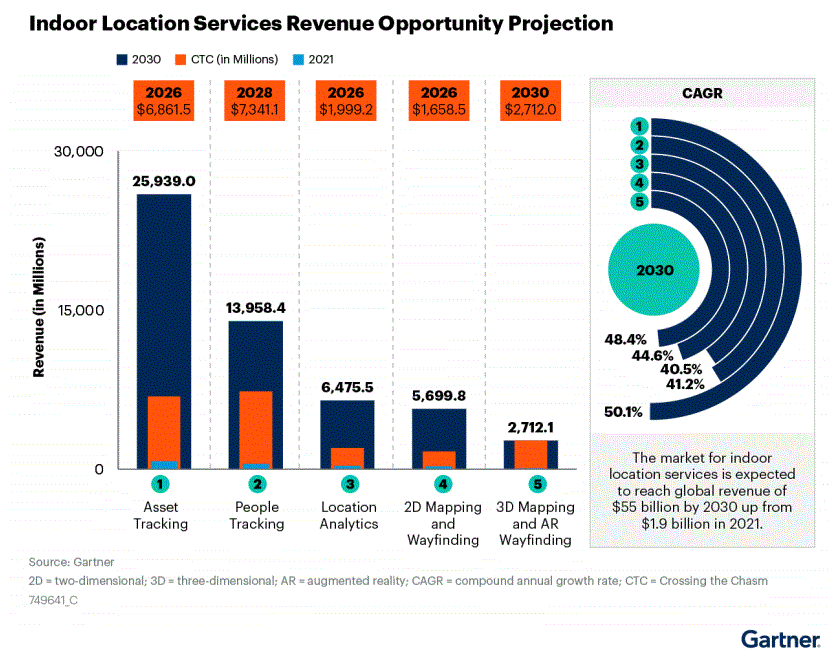
While we like to imagine most people are honest and good by nature, the reality is that customers and suppliers are not going to eager to assist when the subject of locating your missing valuables is brought up. Tough luck.
Instead of playing the blame game, utilizing an RFID system to track each asset as it leaves and returns to the warehouse allows you to instantly establish its specific location, and whether it has yet to return.
This goes for both goods sold as well as the RTIs carrying them. Put another way, your returnables are much more likely to return.
3. Increase Visibility of Container Locations, Available Stock, and Overall Condition
Though shipping should be a precise science, we know that’s not always the case.

Businesses depend on RTIs everyday, but lack visibility over the availability, location, and quality of their RTIs.
When organizations incorporate careful pallet monitoring, tote box tracking, and stillage tracking, it’s much easier to manage a large pool of RTIs without bleeding money. Additionally, there is no longer a need to keep just-in-case containers on the sidelines, because of increased visibility into the “who, what, where, and how many?” questions.
4. Improve Labor Utilization at Every Level of the Supply Chain
Scanning RFID tags takes substantially less time than scanning barcodes. Similarly, RFID is a more appealing identifying solution for reusable assets since users do not need to manufacture new barcodes or print new labels.
Logistics and operational leaders can simply re-encode the same RFID tags again and again without increasing headcount or allocating redundant processes to busy workers.
Lastly, RTLS on RFID can significantly reduce the amount of time workers spend searching for specific inventory. In a field such as healthcare, nurses estimate they spend at least an hour per shift finding equipment. That really adds up when looking at overall labor utilization.
Evaluating and Deploying an Effective RTI Tracking System
Tracking RTIs with RFID helps prevent your assets getting lost or stolen, reduces disputes between trading partners, enables rapid inventory cycle counting, and quickly identifies shortages. Your organization could be saving billions of dollars.
Barcodes, Inc. is your trusted RFID partner and integrator. Contact us when you are ready to elevate your RTI management and discover the magic of RFID tracking. It’s easier to deploy with a partner you can trust.
How to Select, Print, and Encode RFID Tags (Webinar)
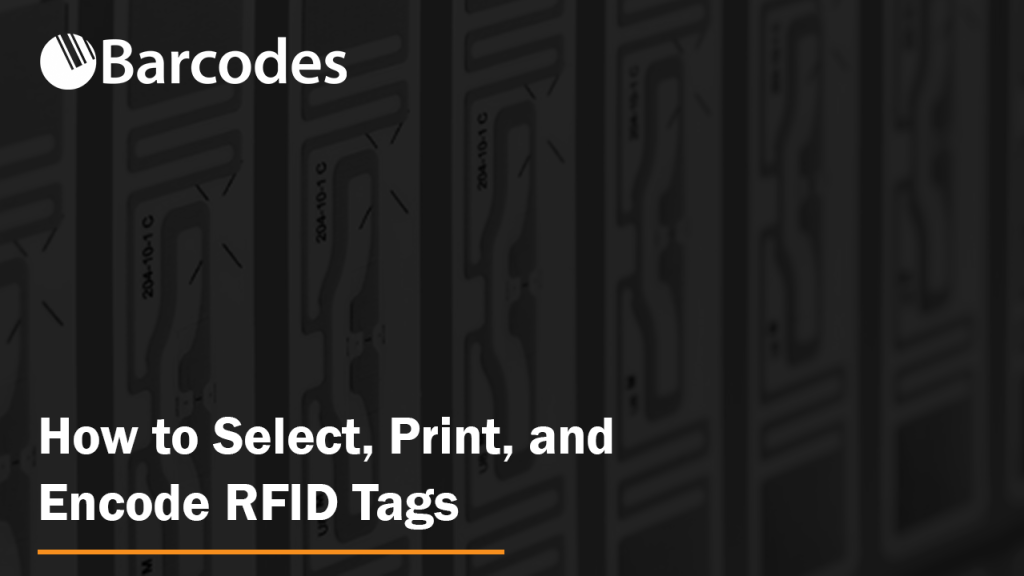
About This Webinar:
How to Select, Print, and Encode RFID Tags
Wednesday, August 3rd, 2:00 PM – 2:30 PM ET
Presented By:
Chris Brown – RFID Subject Matter Expert at TSC Printronix Auto ID
Carlo Emanuele – Vice President and General Manager, Consumables at Barcodes Group
About the RFID Tag Webinar
IDTechEx forecast that 41.2 billion RAIN RFID tags will be sold in 2024, up from 15 billion just three years ago.
To enable you to track your assets with unprecedented accuracy, using the right tag will determine the success of an RFID implementation from the very beginning.
But how do you determine the encoding scheme to use at your organization, and the most appropriate tag or label to support this?
During this webinar, the following questions are answered:
- Why do you need to be concerned about encoding “good data” to RFID tags?
- How do you select an RFID tag that finds the optimal balance between size and read range?
- What role can a partner play in assisting with pre-printed/pre-encoded labels or providing solutions for your on-demand printing?
Watch the RFID Label Webinar
For an assessment of how RFID can improve your inventory accuracy and shipment verification process, please reach out to us at [email protected] or visit www.barcodesinc.com/solutions/learn-more-about-rfid/.
How RFID Cycle Counting Can Increase Speed at Lower Costs (Webinar)

About This Webinar:
RFID Cycle Counting: Increase Inventory Collection Speed at Lower Costs
Thursday, June 30th, 2:00 PM – 2:30 PM ET
Presented By:
Matt Smith – SLS
Christopher Vassilos – Barcodes
Why RFID for Cycle Counting is Transformative
Most businesses today conduct inventory counts as part of their operations. Traditional means of collecting this data include tallying products on a count sheet or scanning barcodes off product labeling, both of which are time consuming and prone to error.
Using RFID technology for cycle counting reduces labor cost and automates the workflow. The result is greater accuracy, improved asset utilization, as well as reducing lost or out of inventory situations.
During this webinar, you will be shown the following:
- A demonstration of cycle counting using RFID technology in action
- An overview of the components of the SLS Mobile Solution
- Various scenarios of deployment, including the use of robotics
Watch the RFID Cycle Counting Webinar Recording
We hope to see you there! For an assessment of your company’s ROI potential with RFID, please reach out to us at [email protected] or visit Barcodes and SLS RFID Solutions.
The Walmart Mandate: Tipping Point for RFID Adoption? (Webinar)
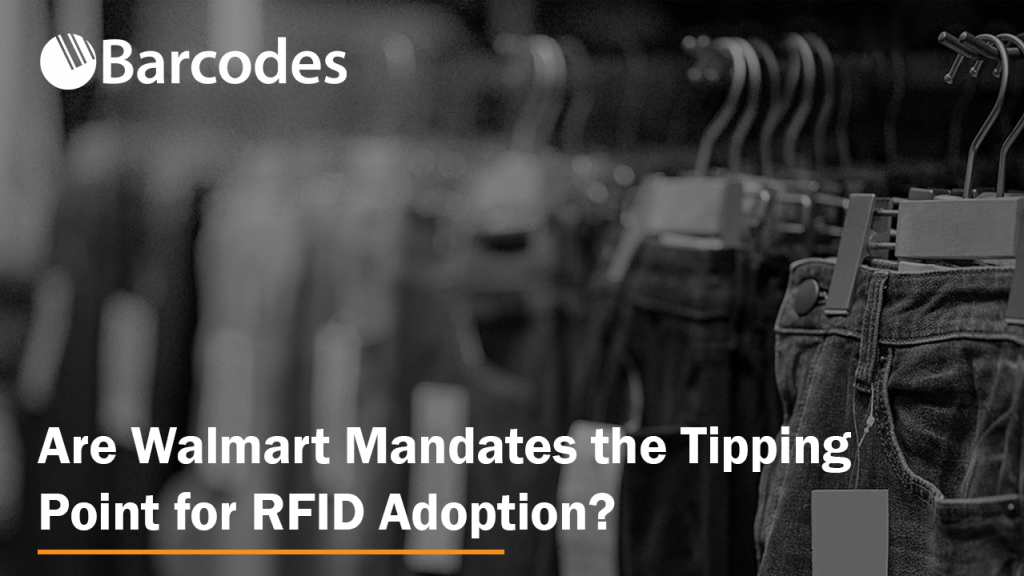
Webinar:
The Walmart Mandate: Tipping Point for RFID Adoption?
Thursday, May 12th, 2:00 P.M. – 2:30 P.M. ET
Presented By:
Todd Muscato – Barcodes Group
Ashley Burkle – Impinj
Ensure Your RFID Labels and Tags are Compliant Before September Deadline
After success using RFID for apparel, Walmart is expanding its RFID mandate to scores of additional products. Could it be a tipping point for RFID adoption in U.S. retail?
With heightened omnichannel demands and continued supply chain disruptions, retailers with inventory accuracy and visibility are thriving. How do you thrive instead of just survive with RFID in retail?
In this webinar, Barcodes and Impinj discuss the following:
- How RFID is helping big brand retailers adapt and thrive
- What retailers and their suppliers need to get started on their RFID journey
- How Barcodes can help with RFID solutions, including devices, software, tags, and support
Watch the Retail RFID Webinar Recording
Learn more about Barcodes’ Walmart RFID solutions, and contact us if you would like to have an exploratory discussion.
How RFID Increases Shipment Accuracy (Webinar)

Webinar:
How RFID Increases Shipment Accuracy
Thursday, March 24, 2022
Presented By:
Jeff Hudson – Barcodes Group
Matt Seltz – Zebra Technologies
Reduce Shipping Chargebacks with Integrated RFID Portal Solutions from Zebra and Barcodes
When your inventory is hard to identify or locate in the warehouse, it leads to incomplete, inaccurate, or delayed shipments. The annual cost of chargebacks due to mistakes in shipping is estimated to be $36B.
Reading RFID tags as they pass through portals or chokepoints is quickly becoming the most efficient and effective means of automating inventory and asset tracking.
Easy to implement and support, Zebra’s new Integrated RFID Portals easily validate shipments as they are loaded on or unloaded from trucks.
During this webinar, we discuss the following ways in which RFID increases shipment accuracy:
- Why RFID drastically reduces the need for human intervention and manual scanning
- What steps companies take to reach a 25% efficiency increase with RFID
- How Zebra’s new Integrated RFID Portals monitor inventory, control costs, and optimize workflows
Watch the Webinar Recording
RFID is a key technology platform that we would love to discuss in more depth with you. In a landscape with lingering supply chain delays and rising labor costs, RFID is one of the most cost effective, scalable, and reliable solutions available today. Learn more about Barcodes’ RFID solutions, and contact us if you would like to have an exploratory discussion.
5 Ways Traceability Can Improve Your Manufacturing Plant

Traceability and visibility are crucial measures for your manufacturing operation and production line. Proper traceability and visibility increase efficiency in the production line by catching defects before they leave the plant, thus reducing recall costs and effects. Without complete visibility, traceability systems will fail to report inaccuracies.
In fact, 69% of companies do not have total visibility over their supply chains, which leads many scrambling to prove everything is up to code during audits and inspections. When defects are identified in a product, organizations need to sort through mounds of data to track and trace raw materials. Otherwise, they may be facing a mass recall. These errors can cost your business millions of dollars, but the good news is that they are avoidable.
Effective tracking and locationing technologies empower manufacturing facilities to deliver fast, accurate, and quality service that secures efficiency for the whole supply chain. See how in our video:
Ensure Proper Tracing and Accurate Visibility with Barcodes, Inc.
Proper tracing and accurate visibility are key components to the well-being of manufacturing plants. Barcodes, Inc. ensures that your manufacturing plant is up to date with integrated solutions. Here are some ways proper tracing and visibility can impact your business.
- Streamline cause analysis – Having access to the data on your products enables manufacturers to dig deep and find the root cause of problems. Identify and solve problems faster to minimize impact.
- Consistent improvement – Once you are able to see how parts and products move through lines, it’s easier to see where improvement is needed. Knowing where and when bottlenecks and delays occur makes real-time optimization possible.
- Enhance your value stream – Since traceability and visibility monitors how your products move through your manufacturing process, it also helps with value stream mapping. Equipped with detailed product genealogy records, manufacturers gain supply chain visibility, which provides your operation the ability to see the bigger picture.
- Quality and engagement – Part traceability along the entire production line can also help find key points where quality check-ups should be added. It also increases accountability and engagement on the shop floor.
- Simple real-time tracking – Easy-to-use technologies such as Zebra’s locationing hardware simplify on-the-fly tracking of your high demand inventory, by digitally connecting data to your centralized management system. This means workers spend less time looking through files and reports for faster and more accurate audits.
Download our brochure to see more ways effective tracking enhances the production floor.
Contact us today to learn more about RFID technology designed to maximize traceability and visibility in your manufacturing plant.
How to Add an Extra Layer of Mobility to Your RFID Tracking System
Given today’s changing customer demands, new safety regulations, and the e-commerce boost, managing inventory continues to be a struggle for most warehouses and distribution centers. As a result, RFID has remained popular across industries since it accelerates throughput while increasing accuracy rates in both the receiving and loading docks. To take RFID efficiency a step farther, we recommend integrating it into your mobile printers with the ZQ630 and ZQ630 RFID:
Why combine mobility and visibility?
Inventory management has been cited as one the top struggles warehouses face today, which means solutions simplifying inventory management can help sharpen your competitive edge. A few issues that further complicate efficient management are:
- Sudden demand increases
- Lagging stock updated that leads to stockouts
- Increasing labor turnover rates that lead to high adoption rates for new technologies
- Lack of real-time visibility
By empowering your workforce with mobile RFID devices, you are able to streamline crucial tasks such as data capture, data sharing, and even label printing, ultimately delivering real-time updates across every avenue your workforce uses. For example, RFID mobile printing allows you to:
- Print updated RFID tags anywhere in your workflow in the event of sudden demand spikes
- Decrease processing time by eliminating unnecessary travel paths
- Deploy an end-to-end tracking system with easy-to-use devices for faster onboarding
- Label incoming inventory immediately with RFID tags to start tracking stock in real-time
- Lower employee density in printing stations
- Increase mobility with lightweight enterprise-grade devices
Working alongside your team, Barcodes, Inc. assists with design, deployment and support services to maximize printer uptime, so your workforce can confidently manage inventory with tools that move with them. Contact us today for a free consultation to see where can implement RFID mobility in your operations.
Why Maximize Visibility in your Work-In-Progress Inventory?
When creating lean operations, manufacturing plants often struggle with managing, incoming materials for future orders, known as work-in-progress (WIP) inventory. If left unchecked, unidentified WIP inventory can increase operational costs by at least 20%[1] while ultimately leading to:
- Increased labor and downtime costs
- Dwindling storage space
- Difficulty tracking assembled orders
- Missed opportunities as decision must be based on available space instead of demand
Better identification equals better visibility
To ascertain material identification for WIP inventory, Barcodes, Inc. recommends modernizing your labeling system. Industrial printers such as Zebra’s ZT610 ensure barcode legibility for both barcode labels and RFID tags, so your team can accurately identify materials as they move throughout the production floor.
By accelerating printing speeds, industrial printers empower teams to quickly tag incoming materials, securing proper storage in the correct location before materials leave the receiving dock. Furthermore, high-resolution barcodes facilitate more successful first-time scans, simplifying your inventory management process as materials move down the supply chain.
However, while industrial printers offer a good place to start enhancing operations, there are many more ways to continue eliminating inefficiency. As a Zebra Premier Business Partner, Barcodes, Inc. works closely alongside your team to design, deploy and support enterprise-grade hardware into your operations. Contact us today to see how you can pair printers like the ZT610 to scanners, mobile computers, and consumables to expand inventory visibility.
[1] Reduce Work-in-Process (WIP) Inventory and Costs. General Electric.



